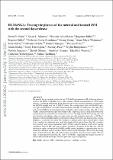HI-MaNGA : tracing the physics of the neutral and ionized ISM with the second data release
Abstract
We present the second data release for the HI-MaNGA programme of HI follow-up observations for the SDSS-IV MaNGA survey. This release contains measurements for 3669 unique galaxies, combining 2108 Green Bank Telescope observations with an updated crossmatch of the MaNGA sample with the ALFALFA survey. We combine these data with MaNGA spectroscopic measurements to examine relationships between HI-to-stellar mass ratio (MHI/M∗) and average ISM/star formation properties probed by optical emission lines. MHI/M∗ is very weakly correlated with the equivalent width of H α, implying a loose connection between the instantaneous star formation rate and the HI reservoir, although the link between MHI/M∗ and star formation strengthens when averaged even over only moderate timescales (∼30 Myrs). Galaxies with elevated HI depletion times have enhanced [OI]/Hα and depressed Hα surface brightness, consistent with more HI residing in a diffuse and/or shock heated phase which is less capable of condensing into molecular clouds. Of all optical lines, MHI/M∗ correlates most strongly with oxygen equivalent width, EW(O), which is likely a result of the existing correlation between MHI/M∗ and gas-phase metallicity. Residuals in the MHI/M∗−EW(O) relation are again correlated with [OI]/H α and H α surface brightness, suggesting they are also driven by variations in the fraction of diffuse and/or shock-heated gas. We recover the strong anti-correlation between MHI/M∗ and gas-phase metallicity seen in previous studies. We also find a relationship between MHI/M∗ and [OI]6302/H α, suggesting that higher fractions of diffuse and/or shock-heated gas are more prevalent in gas-rich galaxies.
Citation
Stark , D V , Masters , K L , Avila-Reese , V , Riffel , R , Riffel , R , Boardman , N F , Zheng , Z , Weijmans , A-M , Dillon , S , Fielder , C , Finnegan , D , Fofie , P , Goddy , J , Harrington , E , Pace , Z , Rujopakarn , W , Samanso , N , Shamsi , S , Sharma , A , Warrick , E , Witherspoon , C & Wolthuis , N 2021 , ' H I -MaNGA : tracing the physics of the neutral and ionized ISM with the second data release ' , Monthly Notices of the Royal Astronomical Society , vol. 503 , no. 1 , pp. 1345–1366 . https://doi.org/10.1093/mnras/stab566
Publication
Monthly Notices of the Royal Astronomical Society
Status
Peer reviewed
ISSN
0035-8711Type
Journal article
Description
Funding: VAR acknowledges financial support from CONACyT grant 285721. ZZ acknowledges support by NSFC grant U1931110. Funding for the Sloan Digital Sky Survey IV has been provided by the Alfred P. Sloan Foundation, the U.S. Department of Energy Office of Science, and the Participating Institutions.Collections
Items in the St Andrews Research Repository are protected by copyright, with all rights reserved, unless otherwise indicated.

